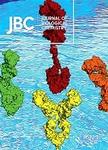版权所有:内蒙古大学图书馆 技术提供:维普资讯• 智图
内蒙古自治区呼和浩特市赛罕区大学西街235号 邮编: 010021

作者机构:Cleveland Clin Fdn Lerner Res Inst Dept Mol Cardiol Cleveland OH 44195 USA
出 版 物:《JOURNAL OF BIOLOGICAL CHEMISTRY》 (生物化学杂志)
年 卷 期:1999年第274卷第11期
页 面:7103-7110页
核心收录:
学科分类:0710[理学-生物学] 071010[理学-生物化学与分子生物学] 07[理学]
基 金:NEI NIH HHS [EY09704] Funding Source: Medline NHLBI NIH HHS [R01 HL064845, R01 HL057470, HL57470] Funding Source: Medline
主 题:血管紧张素Ⅰ/代谢 血管紧张素Ⅱ/激动剂 血管紧张素Ⅱ/类似物和衍生物 血管紧张素Ⅱ/化学 COS细胞 苯丙氨酸/化学 受体 血管紧张素/激动剂 受体 血管紧张素/代谢 酪氨酸/化学 动物
摘 要:We have shown previously that the octapeptide angiotensin II (Ang II) activates the AT, receptor through an induced-fit mechanism (Noda, K,, Feng, Y. H., Liu, X. P., Saad, Y,, Husain, A., and Karnik, S, S. (1996) Biochemistry 35, 16435-16442). In this activation process, interactions between Tyr(4) and Phe(8) of Ang II with Asn(111) and His(256) Of the AT(1) receptor, respectively, are essential for agonism, Here we show that aromaticity, primarily, and size, secondarily, of the Tyr(4) side chain are important in activating the receptor. Activation analysis of AT(1) receptor position 111 mutants by various Ang II position 4 analogues suggests that an amino-aromatic bonding interaction operates between the residue Asn(111) of the AT(1) receptor and Ty(r)4 of Ang II. Degree and potency of AT(1) receptor activation by Ang II can be recreated by a reciprocal exchange of aromatic and amide groups between positions 4 and 111 of Ang II and the AT(1) receptor, respectively. In several other bonding combinations, set up between Ang II position 4 analogues and receptor mutants, the gain of affinity is not accompanied by gain of function, Activation analysis of position 256 receptor mutants by Ang II position 8 analogues suggests that aromaticity of Phe(8) and His256 Side chains is crucial for receptor activation;however, a stacked rather than an amino-aromatic interaction appears to operate at this switch locus. Interaction between these residues, unlike the Tyr(4):Asn(111) interaction, plays an insignificant role in ligand docking.